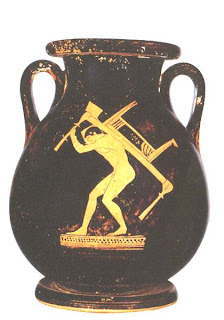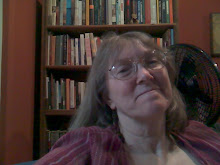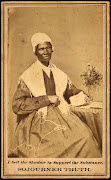Wednesday, August 13, 2008
Women, Beauty, and the Body
A few years back, an art exhibit at Randall Library at UNCW featured the work of Frank Cordelle, a Canadian photographer who captured images and short narratives of women in every year or decade of life. The exhibit was one of the most moving I've ever seen. I recently thought about "The Century Project" when communicating with my cousin Myrna Jacobs, a gifted photographer herself. It turns out that Cordelle has a book including many of these images. The book is going on my Wish List! Cordelle's images of women are relevant to theorist Lennard Davis, et al. since many of the women and girls displayed are damaged psychologically and/or physically. But the camera captures their beauty. Here's Frank Cordelle's web site: http://www.thecenturyproject.com/newsite/main.html
Tuesday, August 12, 2008
Course Description English 387
387-001
History of Literary Criticism and Theory
Joyce HollingsworthTR 2:00-3:15MO 205
Starting with 21st century theorists Lyotard, Butler, and Lennard Davis and his critique of critics blind to the Venus de Milo’s scars and to Medusa’s power, then flashing back to Plato, Aristophanes, and Aristotle, we begin interrogating mimesis and ideals, Plato's perfect forms to which the concrete objects of our world are imitations and art an imitation of an imitation. We’ll explore issues of power, identity, the human body, art, language, and other questions as we progress through a history of ideas about literature, with forays back to the future, reading Wollstonecraft, Keats, Marx, Woolf, Derrida, et al. Relying on analytical discussion of theoretical and literary texts in class, online, in papers and exams, we’ll develop lists of binaries, questions, intertextual connections, etc. See: http://www.joycecthollingsworth.blogspot.com. Many links on the blog where you find yourself now will be important to the course. You will find other important information on the Sea Port web page for your class, as well, as the course proceeds. Book for ENG 387 is David Richter's The Critical Tradition, 3rd Edition, published by Bedford/St. Martin's, 2007 (ISBN 0-312-41520-6).
History of Literary Criticism and Theory
Joyce HollingsworthTR 2:00-3:15MO 205
Starting with 21st century theorists Lyotard, Butler, and Lennard Davis and his critique of critics blind to the Venus de Milo’s scars and to Medusa’s power, then flashing back to Plato, Aristophanes, and Aristotle, we begin interrogating mimesis and ideals, Plato's perfect forms to which the concrete objects of our world are imitations and art an imitation of an imitation. We’ll explore issues of power, identity, the human body, art, language, and other questions as we progress through a history of ideas about literature, with forays back to the future, reading Wollstonecraft, Keats, Marx, Woolf, Derrida, et al. Relying on analytical discussion of theoretical and literary texts in class, online, in papers and exams, we’ll develop lists of binaries, questions, intertextual connections, etc. See: http://www.joycecthollingsworth.blogspot.com. Many links on the blog where you find yourself now will be important to the course. You will find other important information on the Sea Port web page for your class, as well, as the course proceeds. Book for ENG 387 is David Richter's The Critical Tradition, 3rd Edition, published by Bedford/St. Martin's, 2007 (ISBN 0-312-41520-6).
Course Description ENG 380
380-001 MWF 8:00-8:50 380-002 MWF 11:00-11:50
Literature for Children
Joyce HollingsworthMO 207
In ENG 380, students apply close analytical reading and cultural, historical, and literary contexts to texts targeted toward children but often chosen and read by adults. The Children’s Literature field is complex and changing; instead of attempting comprehensive coverage, we’ll focus on the process of reading and selecting classics and new books, examining how children’s literature interacts with popular culture, literary canons, schools, libraries, families, therapy, censorship, the marketplace, etc. We’ll tell stories, share picture books and easy reading materials, and discuss novels and quality nonfiction, developing strategies to help children engage in critical and creative thinking and other pleasures of reading. Papers or exams on books for children ages 9-12, presentation and/or readers’ theatre, discussion leadership and participation, responses to books for younger children. Texts include: Classics of Children's Literature; Nodelman, Pleasures of Children's Literature; Patron, Higher Power of Lucky; Paterson, Bridge to Terabithia; Pullman, His Dark Materials; Curtis, Bud, Not Buddy.
Literature for Children
Joyce HollingsworthMO 207
In ENG 380, students apply close analytical reading and cultural, historical, and literary contexts to texts targeted toward children but often chosen and read by adults. The Children’s Literature field is complex and changing; instead of attempting comprehensive coverage, we’ll focus on the process of reading and selecting classics and new books, examining how children’s literature interacts with popular culture, literary canons, schools, libraries, families, therapy, censorship, the marketplace, etc. We’ll tell stories, share picture books and easy reading materials, and discuss novels and quality nonfiction, developing strategies to help children engage in critical and creative thinking and other pleasures of reading. Papers or exams on books for children ages 9-12, presentation and/or readers’ theatre, discussion leadership and participation, responses to books for younger children. Texts include: Classics of Children's Literature; Nodelman, Pleasures of Children's Literature; Patron, Higher Power of Lucky; Paterson, Bridge to Terabithia; Pullman, His Dark Materials; Curtis, Bud, Not Buddy.
Course Description for ENG 205
205-001 Approaches to the Study of Literature
Joyce HollingsworthMWF 12:00-12:50 MO 202
English 205 allows English majors and other students interested in scholarly writing and critical reading to study and apply major approaches to the analysis of literature, each student developing strategies based on literary theory, reading closely and in context. Emphasis is placed on writing and revising your own essays in response to readings in contemporary and historical poetry, prose, and drama. Papers include short analytical essays and two longer essays that approach their subjects in more depth. We will become a community of readers, expanding the conversation by using the library’s databases and other resources. We’ll practice using MLA style and the conventions of academic writing, editing, and proofreading to produce papers that get well-reasoned ideas a hearing. Texts include: Tyson, Critical Theory Today; Eliot, The Waste Land; Fitzgerald, The Great Gatsby; Shakespeare, Hamlet; Schilb and Clifford, Making Literature Matter.
Joyce HollingsworthMWF 12:00-12:50 MO 202
English 205 allows English majors and other students interested in scholarly writing and critical reading to study and apply major approaches to the analysis of literature, each student developing strategies based on literary theory, reading closely and in context. Emphasis is placed on writing and revising your own essays in response to readings in contemporary and historical poetry, prose, and drama. Papers include short analytical essays and two longer essays that approach their subjects in more depth. We will become a community of readers, expanding the conversation by using the library’s databases and other resources. We’ll practice using MLA style and the conventions of academic writing, editing, and proofreading to produce papers that get well-reasoned ideas a hearing. Texts include: Tyson, Critical Theory Today; Eliot, The Waste Land; Fitzgerald, The Great Gatsby; Shakespeare, Hamlet; Schilb and Clifford, Making Literature Matter.
Greek Beds and Vista Pasting
Thinking about Plato's example of the bed to exemplify his concept of ideal forms, I googled "Greek word bed" in various ways. Most interesting was a thread on a group I think is called B-Greek. They were discussing a New Testament verse in which "two" (duo) were in a bed, specifically asking whether the "two" were specifically both male. The thread wound up discussing the fact that men often shared beds when traveling, as late as Lincoln's time (I'm not sure what Lincoln has to do with it, but that sets off all sorts of connections for me of people sleeping in the Lincoln bedroom in the White House) and about generic pronouns for human beings in various languages. One really interesting post discussed the history of the use of the word "he" to describe both men and women, stating that the word "they" was used in the singular up until about 1745 when a grammar (written by a woman!) prescribed the singular "he" instead. The poster went on to say that it was a man who fought for women's rights who argued in Parliament for women to be included in the idea of "mankind" and to be referred to using the generic "he"; this poster also cites court cases that tried to determine whether or not women are "persons" under the language used in the law--I think this was in Canada. The discussion is worth looking up, sifting through to get all of the thread, if you get the chance. Meanwhile, I started wondering if the word "kline"--the word from which we get "recline" and "clinic"--was the word that Plato used. The thread I mentioned above brought out the fact that Greek (as is usually the case) has more than one word for what we translate into English as bed. One early result: http://www.mlahanas.de/Greeks/Furniture/Furniture.htm.
I'm still researching, but I took a side trip into how to cut and paste using Vista--my current computer related question. I've been frustrated by not being able to highlight a web address, for example, and paste it onto this blog; instead, I've been doing it the (gasp!) old-fashioned way--writing it down, then typing it in. This was especially frustrating when I was posting the course description for my new ENG 387 course on the UNCW English Department site. I couldn't figure out how to copy it from my Vista WORD document to the form provided online and had to retype the whole thing, count words, proofread, etc. Aren't we spoiled?!? I actually can remember the days before computers, typing everything on a manual typewriter, using Wite Out, composing in longhand, etc. In fact, my experience with blogs rather than journals is in its infancy. But this seems to work: Highlight the text you want to copy, hold down Ctrl and hit C on the keyboard. To paste, hold down Ctrl and hit V. Seems to work.
I'm still researching, but I took a side trip into how to cut and paste using Vista--my current computer related question. I've been frustrated by not being able to highlight a web address, for example, and paste it onto this blog; instead, I've been doing it the (gasp!) old-fashioned way--writing it down, then typing it in. This was especially frustrating when I was posting the course description for my new ENG 387 course on the UNCW English Department site. I couldn't figure out how to copy it from my Vista WORD document to the form provided online and had to retype the whole thing, count words, proofread, etc. Aren't we spoiled?!? I actually can remember the days before computers, typing everything on a manual typewriter, using Wite Out, composing in longhand, etc. In fact, my experience with blogs rather than journals is in its infancy. But this seems to work: Highlight the text you want to copy, hold down Ctrl and hit C on the keyboard. To paste, hold down Ctrl and hit V. Seems to work.
Subscribe to:
Comments (Atom)











